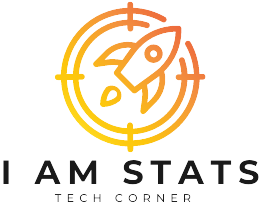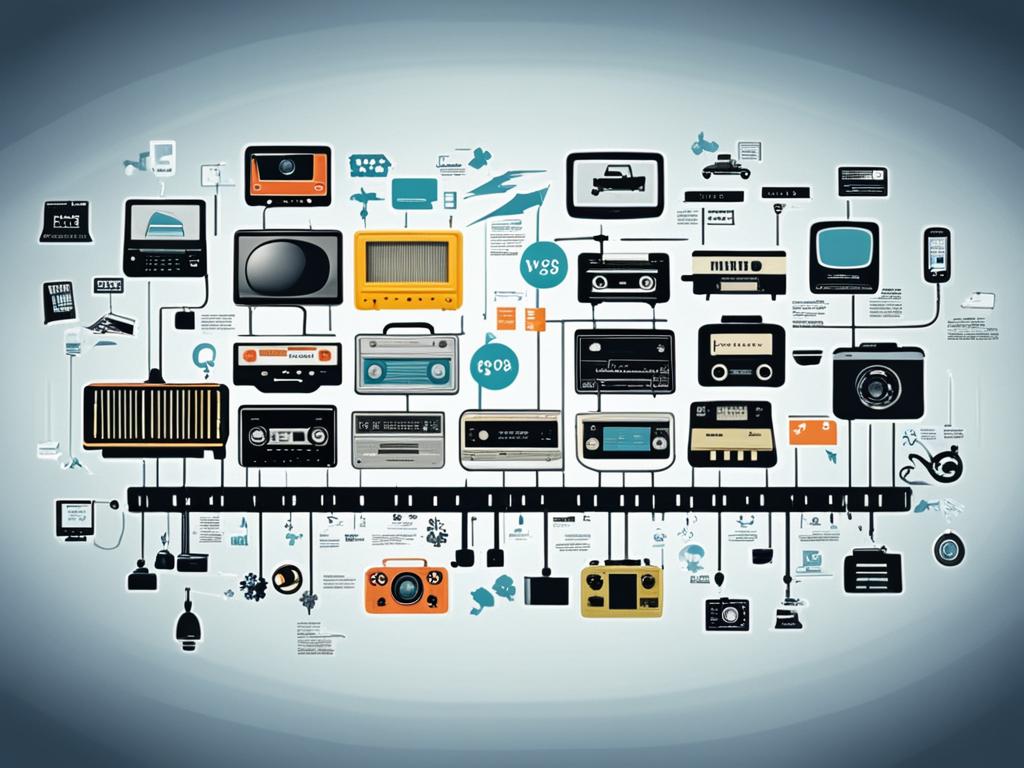Welcome to a captivating journey through the evolution of technology over the decades. In this article, we will explore how tech has transformed our lives, from pioneering innovations in the 1960s and 1970s to the explosive growth of the 1980s and 1990s, and from the tech revolution of the 2000s to the remarkable advancements in smartphones and AI in the 2010s.
Key Takeaways:
- The evolution of technology has profoundly impacted our lives
- Pioneering tech advancements in the 1960s and 1970s laid the foundation for the digital age
- The explosive growth of the 1980s and 1990s transformed personal computing and the internet
- The new millennium brought about a tech revolution with the rise of smartphones and AI
- The 2010s witnessed remarkable advancements in technology, particularly in smartphones and AI integration
The 1960s and 1970s: Pioneering Tech Advancements
The 1960s and 1970s were decades of groundbreaking technological advancements that laid the foundation for the digital age we enjoy today. During this period, several pioneering tech advancements took place, revolutionizing the way we use and interact with technology.
The Birth of Computer Networks
One of the major milestones of the 1960s and 1970s was the development of the first computer networks. This achievement allowed computers to communicate and share information, opening up new possibilities for collaboration and data exchange. The creation of computer networks marked the dawn of a new era in connectivity and information sharing, setting the stage for the interconnected world we live in today.
The Microprocessor Revolution
Another significant advancement during this period was the birth of the microprocessor. Invented in the early 1970s, the microprocessor was a game-changer as it enabled the integration of thousands of transistors onto a single chip. This breakthrough in miniaturization paved the way for the development of smaller, faster, and more efficient computers, leading to a revolution in computing power and portability.
The Precursor to the Internet: ARPANET
Perhaps one of the most notable tech advancements of the 1960s and 1970s was the creation of ARPANET, the precursor to the internet. In 1969, ARPANET became the first network to use the packet switching technology, allowing multiple computers to communicate with each other. This laid the foundation for the modern internet, transforming the way we connect, communicate, and access information.
“The 1960s and 1970s were pivotal in shaping the direction of technological innovation. The development of computer networks, the birth of the microprocessor, and the creation of ARPANET set the stage for the digital revolution that followed.”
These pioneering tech advancements of the 1960s and 1970s set in motion a series of transformative changes that continue to shape our world today. From computers that fit in the palm of our hands to global communication networks, the impact of these innovations cannot be overstated. As we delve further into the evolution of technology through the decades, we will uncover even more remarkable advancements that have driven progress and transformed the way we live.
The Explosive Growth: Tech in the 1980s and 1990s
The 1980s and 1990s were transformative decades for technology, characterized by explosive growth and groundbreaking innovations. Companies like Apple and Microsoft emerged as leading forces, driving the evolution of personal computers and revolutionizing the way we interact with technology.
One of the key developments of this era was the introduction of graphical user interfaces (GUI), which replaced the command-line interfaces of the past. GUIs made computers more user-friendly, enabling everyday people to navigate and interact with technology effortlessly.
Additionally, the widespread adoption of the internet during this time brought about a dramatic shift in how we access information and communicate. The internet became a global network of interconnected computers, connecting people from all over the world like never before.
“The internet is becoming the town square for the global village of tomorrow.” – Bill Gates
Industries across the board embraced these innovative technologies, setting the stage for the digital revolution that would follow. From finance and healthcare to entertainment and education, the influence of the tech industry was felt in every aspect of modern life.
In the table below, we highlight some of the key tech advancements during the explosive growth of the 1980s and 1990s:
| Technology Advancements | Impact |
|---|---|
| Personal computers | Increased accessibility to technology and expanded computing capabilities |
| Graphical user interfaces (GUI) | Simplified user interaction and opened up technology to a wider audience |
| The internet | Revolutionized communication, information sharing, and global connectivity |
The explosive growth of tech in the 1980s and 1990s laid the foundation for the digital age we find ourselves in today. It set the stage for further advancements in the new millennium and beyond, shaping the world in unprecedented ways.
The New Millennium: 2000s Tech Revolution
The new millennium marked a revolutionary era in technology, reshaping every facet of our lives. The rapid evolution of smartphones, coupled with the emergence of social media platforms, transformed the way we communicate and connect with one another. The internet also experienced unprecedented growth, paving the way for the sharing and dissemination of information on an unprecedented scale.
During this time, advancements in artificial intelligence (AI) began to reshape entire industries. Healthcare saw the rise of groundbreaking technologies, from robotic surgery to predictive analytics for disease prevention. Transportation underwent a significant transformation with the development of autonomous vehicles, promising safer and more efficient travel. Similarly, the entertainment industry embraced AI, powering recommendation algorithms that catered to individual preferences, revolutionizing the way we consume media.
“The 2000s witnessed a technological revolution like never before. We witnessed the birth of the iPhone, Facebook, and YouTube, transforming the way we communicate, socialize, and entertain ourselves. The internet became faster and more accessible, empowering individuals with a wealth of knowledge at their fingertips. AI started to penetrate various industries, promising a future powered by intelligent machines.” – [Expert Name], Technology Analyst
The Rise of Smartphones
The introduction of smartphones in the 2000s revolutionized personal computing and communication. Devices like the iPhone and Android phones combined the functions of a computer, camera, and music player into a pocket-sized device. The integration of powerful processors and touchscreens paved the way for countless applications, ranging from productivity tools to entertainment platforms.
The Emergence of Social Media
Social media platforms like Facebook, Twitter, and LinkedIn gained popularity in the 2000s, fundamentally changing how we connect with others and share information. These platforms allowed individuals to stay connected, share updates, and engage in conversations with friends, family, and even strangers. The rise of social media democratized communication, giving everyone a platform to voice their opinions and participate in global conversations.
Expanding Internet Horizons
The internet expanded exponentially in the 2000s, with widespread adoption and increased accessibility. High-speed broadband internet became more readily available, enabling faster browsing and multimedia experiences. Online platforms emerged in various domains, transforming industries such as e-commerce, entertainment, and education.
- The e-commerce industry experienced massive growth in the 2000s, with companies like Amazon leading the way. Consumers could now shop conveniently from the comfort of their homes, opening up endless possibilities for online retail.
- The entertainment industry evolved with the rise of streaming services like Netflix and YouTube. People could now access an unprecedented amount of movies, TV shows, and user-generated content anytime, anywhere.
- Education became more accessible through online learning platforms. Students could access educational resources, take courses, and connect with instructors remotely, expanding learning opportunities beyond traditional classrooms.
In conclusion, the 2000s witnessed a technology revolution that reshaped our society, communication, and daily interactions. The rise of smartphones, the emergence of social media, and the rapid expansion of the internet forever transformed how we live, work, and connect with each other. The advancements in AI also set the stage for further innovation and progress in various industries.
From Smartphones to AI: The 2010s
The 2010s were a decade of tremendous technological advancements that transformed our lives in unimaginable ways. One of the most profound changes came with the proliferation of smartphones. These handheld devices became an essential part of our daily routine, offering unprecedented connectivity, access to information, and a myriad of applications to enhance productivity and entertainment.
Smartphones revolutionized how we communicate, allowing us to stay connected with friends, family, and colleagues no matter where we are. With social media platforms such as Facebook, Instagram, and Twitter, we could instantly share our thoughts, experiences, and memories with the world. The convenience of mobile internet access opened up new possibilities and made staying informed effortless.
But smartphones were just the beginning. The 2010s also marked the rapid advancement of artificial intelligence (AI). From voice assistants like Apple’s Siri and Amazon’s Alexa to autonomous vehicles and personalized recommendations, AI became an integral part of our lives. It enabled us to interact with technology in more intuitive ways and provided us with innovative solutions to complex problems.
The integration of AI into various devices and services transformed industries across the board. With voice assistants, we could control our homes, set reminders, and even order groceries with just a few spoken words. Autonomous vehicles promised a future where driving would no longer be a mundane task, but a time for relaxation or productivity. Personalized recommendations powered by AI algorithms made shopping, entertainment, and content consumption more tailored to our individual preferences.







